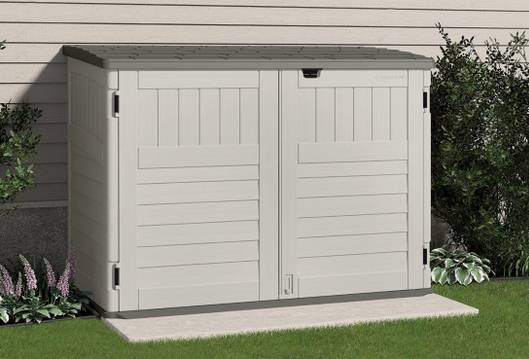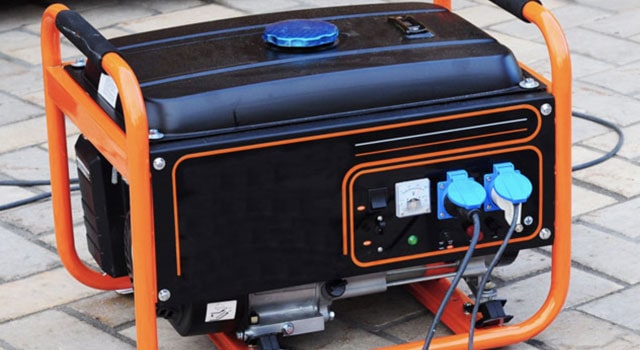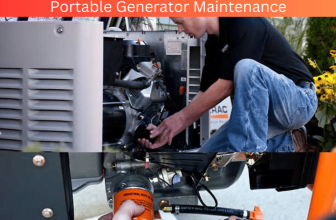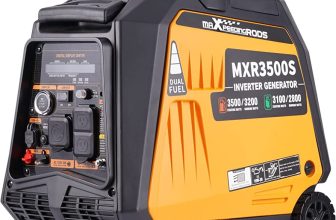When it comes to portable generators most people want nothing more than for them to function smoothly when needed without any problems arising. However very few people put much thought into the necessity of proper storage and maintenance until something goes wrong unexpectedly. If long lasting usage is what you’re after though then taking care of your device consistently is crucially important indeed! The good news?
This isn’t an overly challenging task – there are just a few core elements worth paying attention too! In this article therefore I’ll provide guidance on everything you need in order to achieve optimal storage conditions with ease.
Regardless of make or model appropriate storage is a vital factor in ensuring the longevity potential your portable generator possesses overall.
The benefits here are twofold: safeguarding your investment against environmental risks while also helping to mitigate any potential mechanical issues down the line. With some forethought and research then anyone can help ensure their generator operates at peak performance for years to come.
So if you’re ready to do just that lets delve into what it takes when it comes to proper storage of your device!

Image Credit: nooutage
Why Proper Storage Is Important
Your portable generator is an investment worth protecting – both for your convenience today and as an emergency back up for tomorrow. Thus making sure it performs at its best requires proper care – including storing it correctly.
Luckily these steps are straightforward but essential to ensuring years of reliable use for your machine! The key is finding the right environment for your generator: dry, cool well ventilated; away from any combustible materials; protected from harsh weather conditions while maintaining sufficient airflow around it. Also vital is ensuring that fuel leaks or vapors pose no risk to surrounding areas. By following these tips for proper storage of your portable generator; you can help ensure its longevity while getting the most out of this critical piece of equipment!

Image Credit: briggsandstratton
Selecting A Proper Storage Area
When packing away your portable generator after use the first order of business is deciding on a secure storage area thats dry and free from combustible materials – so important! A good spot will not only extend the lifespan of your unit but also prevent potential hazards like fires. Here are some considerations I’ve put together in table form to guide you through this decision making process:
| Consideration | Reason |
|---|---|
| Security | Deters theft or vandalism |
| Dryness | Reduces likelihood of corrosion or rust forming |
| Combustible materials | Limits chance of fire dangers |
As evidenced by this chart selecting an appropriate storage location for your generator is key in safeguarding it against common risks such as theft, corrosiveness, and fires. Once you have picked out a spot that meets these requirements lets prepare your power source properly for safekeeping until next time you need it!

Image Credit: nooutage
Preparing The Generator For Storage
We’re at the finish line! Before stashing our trusty generator away safely until we next need it lets make sure we take all necessary precautions to prepare it for storage thoroughly. The critical first step is emptying the fuel tank and carburetor completely to prevent moisture or debris from causing engine damage during its period of inactivity.
The last thing anyone wants is a malfunctioning or rusty generator!
Once done with that run your engine until it uses up all remaining fuel before removing and storing the battery separately. Don't neglect cleaning procedures either – ensure to properly clean using a damp cloth before lubricating any moving parts that may require it.
By following these guidelines closely you'll guarantee the longevity of your generator while safeguarding against unforeseen issues when next required.
Image Credit: blog
Utilizing The Right Storage Materials
After putting away your generator safely following essential prepping exercises, it’s now time to find appropriate materials for its storage purposes. Choosing suitable materials fosters a conducive environment that guarantees keeping the equipment protected from damage while resting unless used sparingly.
Moisture regulation stands out as an essential factor since excessive moistures can corrode engine parts causing costly repairs or replacements.
To protect against unwanted moistures without compromising air circulation around the machine; waterproof covers made from tarpaulin or other breathable fabrics come in handy.
Another advantage of adding a desiccant pack inside storage spaces ensures any excess moisture gets absorbed quickly.
Following these simple techniques provides maximum functionality of your portable generator with minimal maintenance needs throughout its lifetime by ensuring you keep off expensive repairs due to poor care practices during non-use days; hence you’re sure to have it ready for usage whenever called upon. Now comes the crucial step of preparing the generator for storage – giving it a thorough cleaning first.

Image Credit: nooutage
Cleaning The Generator And Storing It Properly
Proper care of your generator is essential if you want it running for an extended period of time without complications. Cleaning and storing it appropriately play paramount roles in ensuring hassle free use throughout its lifespan.
Before starting cleaning procedures turn off your generator entirely so as not to cause any damage accidentally. You can then work on removing debris or dirt from around the area before wiping down all surfaces with a damp cloth thoroughly.
Make sure enough drying time has passed before moving forward; inspect all connections carefully as well- ensuring no looseness or brokenness exists still on your device following the initial cleaning process.
Add some lubrication oil (if required) to maintain smooth operation when stored away idle for extended periods; finally store in an appropriate area where no extreme temperature fluctuations or high humidities affect its performance over time. Remember ventilation requirements and try not to overcrowd the area so your generator gets enough fresh air while not taking up too much space in an already crowded storage area. With these essential steps taken you can be confident that your generator will stay in excellent working condition and serve you dependably for several years.
Furthermore let us explore how to sustain perfect temperature and humidity levels during the operation of your portable generator.

Image Credit: woodstockpower
Maintaining Ideal Temperature And Humidity Levels
After giving your generator the care it deserves with cleaning and proper storage don’t neglect the importance of maintaining ideal temperature and humidity levels for long term performance. Prevent overheating by keeping the portable generator away from direct sunlight as well as extreme hot or cold weather conditions – either use a climate controlled room or cover with a tarp.
Avoid environmental risks associated with high levels of humidity such as corrosion on metal parts or static electricity build up that increases friction between moving parts; these risks are best mitigated through storage in locations with moderate temperature (between 40 80°F/4 27°C) and lower relative humidity (less than 50%). Striking this balance will prolong the lifespan of your device. Taking the time to inspect your generator both before and after storing it for a lengthier duration is a crucial aspect of guaranteeing its longevity.

Image Credit: plymouthrock
Examining The Generator Before And After Storage
Taking care of your generator starts with being diligent about inspections before and after storage periods.
Whenever its time to remove your machine from storage its critical first to give everything an excellent visual checkup identifying any potential warning signs such as damage or corrosion. Next up comes checking oil levels which should be adequate for proper running status as well as inspecting air filters and spark plugs – two vital components requiring thorough examination. If anything seems amiss with these critical pieces of equipment (whether due to wear and tear or other types of damage) you’ll want to address them immediately. After this initial round up comes inspecting all connecting materials like cables, wires, and hoses for signs of deterioration or damage. In case anything looks iffy here replacing the affected parts will help avoid future issues when you’re ready to use the generator again.
Once all these steps are completed remember to give your equipment one last close up before firing it up. A fine tooth comb approach will ensure nothing gets missed during this final inspection phase! As someone who has received higher education I understand that dealing with minor concerns is a must. Its vital to stay vigilant and catch these issues before they snowball into more significant troubles later on. Now that all necessary precautions have been undertaken successfully its time for me to move forward with connecting and testing the generator consistently.

Image Credit: mygenerator
Connecting And Testing The Generator Regularly
Sustaining optimal performance of your generator requires periodic maintenance checks. Here’s what you need to do for best results.
Firstly, connect your generator with an outdoor-approved three-pronged cord into an appropriate power source.
Confirm that the circuit breaker switch is turned on followed by checking fuel levels before igniting the engine with the key switch.
Afterward, inspect each component as listed below regularly:
| Component | Frequency |
|---|---|
| Oil Level | Every 6 months |
| Air Filter | Every 12 Months |
| Spark Plugs | Every 12 Months |
| Fuel Hose & Fitting | Annually |
| Battery Cables & Terminals | Annually |
Lastly, test run your generator for at least fifteen minutes after thoroughly examining all components listed above to ensure optimum performance every time you use it! We all know that time flies when we’re not paying attention- but neglecting proper maintenance for our generators is not an option! Regular checks keep us aware of potential issues before they turn into something more significant; leaving us with no backup power supply when we need it most! But don’t worry- we’ve got you covered! Next up is protecting your investment with some tips on how best to tackle moisture and corrosion prevention measures!

Image Credit: woodstockpower
Protecting The Generator From Moisture And Corrosion
Now that we’ve discussed how vital it is to regularly connect and test your generator equipment lets shift our focus towards keeping it safe from moisture and corrosion.
The key method in doing so is by maintaining a well ventilated storage area for your unit that isn’t exposed to rain or excessive humidity. As an additional precautionary measure ensure that your equipment stays dry by keeping it elevated above ground level when storing it away.
Also essential is taking some time every couple of months for cleaning out dust/debris buildup on the machine; this will help prevent corrosion while reducing future difficulties caused by dirt accumulation inside the device itself.
Moreover inspect all wiring connections frequently for signs of wear or rusting as this could lead down problems in time if not addressed at an early stage adequately. Lastly remember always to use an appropriate cover when storing the portable generator outdoors; this will protect it against environmental hazards like leaves/twigs/rodents while safeguarding against weather damage over time.
Implement these straightforward measures and enjoy uninterrupted power supply for years to come.
After ensuring our preparatory measures are complete, let’s shift our focus to identifying and addressing typical complications associated with operating a portable generator.

Image Credit: huffpost
Troubleshooting Common Issues With Portable Generators
Portable generators are convenient devices we rely upon during emergencies or outdoor activities but they can also pose some issues at times that require troubleshooting assistance.
One such problem often encountered is when your generator fails to start up completely. In most cases this could mean a bad spark plug clogged fuel filter or even a faulty battery – therefore checking these components should always be done first.
For more extreme cases consulting with qualified technicians may become necessary.
Another common issue spotted with portable generators is unsatisfactory power output which can occur due to factors such as an oversized load, incorrect wiring or inadequate oil levels leading to malfunctions of parts requiring proper installation.
To avoid this one can recheck all connections, wiring and oil levels to ensure that everything has been set up correctly.
Lastly if your generator isn’t producing any power at all then its possible its drawing in too much energy – which causes the circuit breaker switch to disrupt operations.
In order to fix this issue you need to reset the circuit breaker while also reducing the energy draw on your device if needed.
Let me stress the importance of consulting your manufacturers manual when attempting to troubleshoot device issues. These guides are uniquely tailored to each model and can provide valuable insight into identifying potential problems.

Image Credit: webstaurantstore
Frequently Asked Questions

Image Credit: dynamicgrp
How Often Should I Check My Generator Before And After Storage?
Proper upkeep of your generator entails carrying out routine checks both before putting it away for storing and upon retrieval from stored positions to ensure longevity and reliability of its operations.
Before keeping the device away ,go through all safety protocols such as fluid level checkups with close attention paid to the state of seals ,air filters ,and plugs .During unpacking from storage ,do another thorough inspection of these parts with keen eyesight .It is vital that any damages are noted early enough in order not compromise performance .Take time to effect repairs as appropriate prior usage.The outcome should be a consistently performing trusty generator that meets all power supply needs on demand.
What Type Of Fuel Should I Use In My Portable Generator?
The longevity of your portable generator relies heavily on utilizing an appropriate fuel source. Opting for a specialized option meant explicitly for generators can contribute toward preventing corrosion that may otherwise damage critical engine components in time.
Should doubts arise regarding what type of fuel would be most advantageous, refer back either to your product handbook or get in touch with customer service representatives who possess expert knowledge and are available to provide support on select-ing an aptly compatible gasoline variant based on individual models.
Are There Any Safety Concerns I Should Be Aware Of When Using A Portable Generator?
Using a portable generator could be an excellent decision when theres no power at home; however keep safety guidelines in mind during its operation.
The first thing that should concern you is placing it way far from the house and in an open air place providing sufficient air circulation.
In no circumstances should you attempt to refuel while running or hot as this could create accidental fires or explosions causing severe harm. Furthermore failures when selecting fuel types and not checking cords for outdoor use can break your appliances and cause electric shocks.
Its essential to verify local laws regarding portable generator use before commencing it to avoid running into legal issues.
Is It Necessary To Use A Cover For My Generator When It Is In Storage?
For optimum preservation of your portable generator during periods of inactivity, consider sheltering it with a protective covering.
Although not strictly essential; the advantages are considerable in preventing adverse conditions like dust accumulation or moisture build-up over time .
As an added bonus , this extra layer will prove useful in keeping critters at bay from wreaking unintentional harm .
Also important along with using a covering , is finding adequate storage space that’s sufficiently ventilated , cooler temperature-controlled and free of dampness .
What Is The Best Way To Store Fuel For My Generator In Order To Ensure Its Longevity?
To keep your generator running smoothly for years on end proper storage of its fuel should be at the top of your priority list. Fuel stabilizers are highly recommended to keep gasoline fresh and prevent degradation that can hinder performance in the long run.
But whats equally important is how you store that stabilized fuel once you’ve got it. Your best bet is an airtight container like a plastic jerry can so that no air or moisture gets inside which could negatively impact overall quality and performance when needed.
And don’t forget about checking those expiration dates beforehand! You definitely don’t want any damaged goods damaging your machine if expired gasoline has been sitting for too long.
Conclusion
For any owner looking to keep their portable power source going strong year after year (and who isn’t?) proper storage is non negotiable! Take time before stowing away your machine – inspect thoroughly beforehand & ensure suitable fuel is being used.
Safety changes nothing in this regard so be mindful of best practices when employing your portable generator.
For instance covering the unit while not in use can save you from weather damage – and don’t forget about storing any fuel safely too! Just by paying heed to these fundamental tips your portable generator should last you for many years to come.
Image Credit: pinterest





